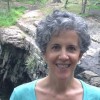Most of us, at some point in our lives, have asked the question, “Who am I?”
And in one way or another, it keeps coming up. If you have ever had to write a resume, or a professional bio of yourself, or even a profile for an online dating site, then you know just how fraught the question can become.
I recently noticed that my bio at the studio where I teach yoga was quite out of date. Because new students tell me that they do read these profiles before trying a class, it seemed a good idea to keep my page current. I thought that the update would be an easy walk in the park, but it ended up feeling more like a sweaty trek down a thorny, unmarked path.
I don’t really think my problem was ego, it felt a lot more like confusion. It seemed weird to describe myself by listing credentials, or even by delineating the qualities and intentions of my teaching, when yoga, in fact, is blasting all of this open for me on an almost daily basis. And, in a way, this blasting open is what I hope for for my students.
Some of us remember asking, “Who am I?” as a young child. It’s a question of such innocence and simplicity, yet it leads us right to the center of one of life’s greatest mysteries. Yoga, or any mindfulness practice, can help us begin to realize we are not our thoughts, we are not our feelings, we are not our bodies, and we cannot be defined by the trappings of a profession or the qualities of a personality.
Over time we may notice that all of these aspects of who we thought we are remain in flux, and sometimes to a dizzying degree. It is no surprise then that we look for something (anything) to hang on to.
Unfortunately, however, the hanging on can be exhausting.
At a certain point we sense the futility of this tight grip on a rigid notion of how we think we are and, especially, how it should all unfold. I laughed in recognition when I heard the Buddhist teacher and funnyman, Wes Nisker, say that when he first learned about the crime of identity theft, he was thrilled, “Yes! Take my identity please (but leave the cash)!”
When I practice yoga, I tune in to the particular drama of my own body in space and time—today’s aches, yesterday’s over-indulgence of pasta, last night’s lack of sleep. These qualities are like the spices that flavor the base ingredient of mindfulness and render my practice sweet or bitter and, most often, a combination of the two. Other ingredients that join me on the mat of course are my moods and my thoughts. And yet, whatever the soup of the day, almost inevitably, after savasana (final resting pose) when the class is done and I sit up for a final om, I feel bigger, clearer and more connected.
Having taken the time to be present with the changing nature of my experience, I sometimes touch just beyond it.
Mindfulness has moved beyond particular flavors and tastes and becomes primarily and joyfully of itself. It is as though the boundaries of my individual body and experience are no longer solid, but connected to something much more vast.
If you’ve been in a yoga class in the last ten years, then you have probably heard that each of us contains actual stardust from the original big bang. As astronomer Carl Sagan explains it, “The nitrogen in our DNA, the calcium in our teeth, the iron in our blood, the carbon in our apple pies were made in the interiors of collapsing stars. We are made of star-stuff.”
Whether you practice mindfulness through yoga, meditation, art or love, the journey inward can ultimately be one of expansiveness, an opportunity to remember who you really are. This sense of connection is not so much defining, as liberating.
In describing the discoveries of his own practice, again, Wes Nisker puts it very well, “I was not who I thought I was. I was so much more.”
Love elephant and want to go steady?
Sign up for our (curated) daily and weekly newsletters!
Assistant Editor: Tifany Lee/Editor: Bryonie Wise
Photo: Wiki Commons










Read 2 comments and reply